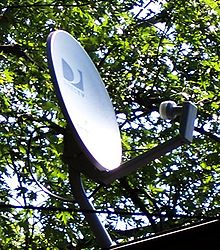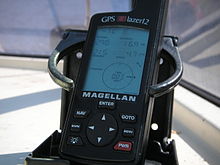- Commercialization of space
-
 A DIRECTV satellite dish on a roof
A DIRECTV satellite dish on a roof
Commercialization of space is the use of equipment sent into or through outer space to provide goods or services of commercial value, either by a corporation or state. Examples of the commercial use of space include satellite navigation systems, satellite television and satellite radio. In 2004, global investment in all space sectors was estimated to be $50.8 billion.[1]
Contents
History
The first commercial use of satellites may have been the Telstar 1 satellite, launched in 1962, which was the first privately-sponsored space launch, funded by AT&T and Bell Telephone Laboratories. Telstar 1 was capable of relaying television signals across the Atlantic Ocean, and was the first satellite to transmit live television, telephone, fax, and other data signals.[2][3] Two years later, the Hughes Aircraft Company developed the Syncom 3 satellite, a geosynchronous communications satellite, leased to the Department of Defense. Commercial possibilities of satellites were further realized when the Syncom 3, orbiting near the International Date Line, was used to telecast the 1964 Olympic Games from Tokyo to the United States.[4][5]
Between 1960 and 1966, NASA launched a series of early weather satellites known as Television Infrared Observation Satellites (TIROS). These satellites greatly advanced meteorology worldwide, as satellite imagery was used for better forecasting, for both public and commercial interests.[6][7]
On April 6, 1965, the Hughes Aircraft Company placed the Intelsat I communications satellite geosynchronous orbit over the Atlantic Ocean. Intelsat I was built for the Communications Satellite Corporation (COMSAT), and demonstrated that satellite-based communication was commercially feasible. Intelsat I allowed for near-instantaneous contact between Europe and North America by handling television, telephone and fax transmissions.[8][9] Two years later, the Soviet Union launched the Orbita satellite, which provided television signals across Russia, and started the first national satellite television network.[10][11] Similarly, the 1972 Anik A satellite, launched by Telesat Canada, allowed the Canadian Broadcasting Corporation to reach northern Canada for the first time.[12][13]
Beginning in 1997, Iridium Communications began launching a series of satellites known as the Iridium satellite constellation, which provided the first satellites for direct satellite telephone service.[14][15]
Subscription satellite services
See also: Direct broadcast satellite and Satellite radioIn 1994, DirecTV debuted by introducing a dish 18 inches in diameter. In 1996, Astro started in Malaysia with the launch of the MEASAT satellite. In November 1999, the Satellite Home Viewer Improvement Act became law, and local stations were then made available in satellite channel packages, fueling the industry’s growth in the years that followed. By the end of 2000, DTH subscriptions totaled over 67 million.[citation needed]
Transponder leasing
Businesses that operate satellites often lease or sell access to their satellites to data relay and telecommunication firms. This service is often referred to as transponder leasing. Between 1996 and 2002, this industry experienced a 15 percent annual growth. The United States accounts for about 32 percent of the world’s transponder market.[citation needed]
Ground equipment manufacturing
Operating satellites communicate via receivers and transmitters on Earth. The manufacturing of satellite communication terminals (including VSATs), mobile satellite telephones, and home television receivers are a part of the ground equipment manufacturing sector. This sector grew through the latter half of the 1990s as it manufactured equipment for the satellite services sector. Between the years of 1996 and 2002 this industry saw a 14 percent annual increase.[citation needed]
Satellite manufacturing
Commercial satellite manufacturing is defined by the United States government as satellites manufactured for civilian government or non-profit use. Not included are satellites constructed for military use, nor for activities associated with any human space flight program. Between the years of 1996 and 2002, satellite manufacturing within the United States experienced an annual growth of 11 percent. The rest of the world experienced higher growth levels of around 13 percent. Less than 43 percent of the satellites launched in 2002 for commercial use were manufactured in the United States.
Satellite imagery
Main article: Earth observation satelliteSeveral operators of Earth observation satellites, such as GeoEye and Spot Image, provide images commercially.[citation needed]
Main article: Global Navigation Satellite SystemSpace transportation
Main article: Space transportationSee also: Point-to-point sub-orbital spaceflightThe commercial space transportation industry derives the bulk of its revenue from the launching of satellites into the Earth’s orbit. Commercial launch providers typically place private and government satellites into Low Earth Orbit (LEO). In 2002, commercial space transportation generated 6.6 billion dollars, which made up 6% of the total gross of commercial space activities.[citation needed]
The Federal Aviation Administration (FAA) has licensed four commercial spaceports in the United States: the Virginia Space Flight Center/Wallops Flight Facility, Kodiak Launch Complex, Spaceport Florida/Kennedy Space Center/Cape Canaveral Air Force Station, and the California Spaceport/Vandenberg AFB. Launch sites within Russia and China have added to the global commercial launch capacity. The Delta IV and Atlas V family of launch vehicles are made available for commercial ventures for the United States, while Russia promotes eight families of vehicles. The three largest Russian systems are the Proton, Soyuz, and Zenit.[citation needed]
Between 1996 and 2002, 245 launches were made for commercial ventures while government (non-classified) launches only total 167 for the same period. Commercial space flight has spurred investment into the development of an efficient reusable launch vehicle (RLV) which can place larger payloads into orbit. Several companies such as SpaceX are currently creating new RLV designs.
Space tourism
Main article: Space tourismSpace tourism is space travel by individuals for the purpose of personal pleasure. The space tourism industry is being targeted by spaceports in numerous locations, including the Mojave Air and Space Port in California,[16][17] the Clinton-Sherman Industrial Airpark near Burns Flat, Oklahoma[18][19] Spaceport America in Sierra County, New Mexico,[20][21] the Mid-Atlantic Regional Spaceport on the Delmarva Peninsula in Virginia,[22][23] the Kodiak Launch Complex on Kodiak Island, Alaska,[24][25] and the Esrange Space Center in Kiruna, Sweden.[26][27]
Proposed spaceports targeting commercial activity include the Ras Al Khaimah spaceport in Ras al-Khaimah, United Arab Emirates,[28][29] Spaceport Sheboygan near Sheboygan, Wisconsin,[30][31] and Singapore spaceport near Singapore's Changi Airport[32][33]
Regulation
In the United States, Office of Commercial Space Transportation (generally referred to as FAA/AST or simply AST) is the branch of Federal Aviation Administration (FAA) that approves any commercial rocket launch operations—that is, any launches that are not classified as model, amateur, or "by and for the government."[34]
See also
Notes
- ^ Romano, Anthony F. (2005). "SPACE A Report on the Industry". Defense Technical Information Center. http://www.dtic.mil/cgi-bin/GetTRDoc?Location=U2&doc=GetTRDoc.pdf&AD=ADA449454. Retrieved 15 May 2011.
- ^ National Geographic (May 1962). "Telephone a Star". http://www.porticus.org/bell/pdf/nat_geo_telstar_ocr.pdf. Retrieved 15 May 2011.
- ^ NASA (26 April 2011). "Telstar 1". NASA. http://nssdc.gsfc.nasa.gov/nmc/spacecraftDisplay.do?id=1962-029A. Retrieved 15 May 2011.
- ^ "Significant Achievements in Space Communications and Navigation, 1958-1964". NASA-SP-93. NASA. 1966. pp. 30–32. http://ntrs.nasa.gov/archive/nasa/casi.ntrs.nasa.gov/19660009169_1966009169.pdf. Retrieved 2009-10-31.
- ^ "Syncom 3". NASA. 26 April 2011. http://nssdc.gsfc.nasa.gov/nmc/masterCatalog.do?sc=1964-047A. Retrieved 16 May 2011.
- ^ "TIROS". NASA. http://science.nasa.gov/missions/tiros/. Retrieved 16 May 2011.
- ^ Hastings, David A.; William J. Emery (1992). [http://www.ngdc.noaa.gov/ecosys/cdroms/AVHRR97_d1/avhrr2.htm "The Advanced Very High Resolution Radiometer (AVHRR): A Brief Reference Guide"]. National Oceanic and Atmospheric Administration. http://www.ngdc.noaa.gov/ecosys/cdroms/AVHRR97_d1/avhrr2.htm. Retrieved 16 May 2011.
- ^ Whalen, David J. (30 November 2010). "Communications Satellites: Making the Global Village Possible". NASA. http://history.nasa.gov/satcomhistory.html. Retrieved 16 May 2011.
- ^ "Intelsat's Satellite Communication Highlights from the 60's". Intelsat. http://www.intelsat.com/about-us/history/intelsat-1960s.asp. Retrieved 16 May 2011.
- ^ Martin, Donald H. (2000). Communication satellites. AIAA. p. 220. ISBN 9781884989094.
- ^ Putkov, Vladimir (April 2007). "Sputnik and Russia's Outer Space Activities". United Nations Institute for Disarmament Research. http://www.unidir.org/pdf/articles/pdf-art2661.pdf. Retrieved 16 May 2011.
- ^ "The World's First National Synchronous Communications Satellite". Boeing Company. 2011. http://www.boeing.com/defense-space/space/bss/factsheets/376/anik_a/anik_a.html. Retrieved 16 May 2011.
- ^ "ANIK The World's First Domestic Synchronous Communication Satellite". Institute of Electrical and Electronics Engineers. http://www.ieee.ca/millennium/anik/anik_about.html. Retrieved 16 May 2011.
- ^ "Iridium – the satellite phone always rings twice". Wired. 7 March 1999. http://www.wiredreread.com/2010/03/iridium-satellite-phone-always-rings.html. Retrieved 13 June 2011.
- ^ "Commercial Space Transportation QUARTERLY LAUNCH REPORT". Federal Aviation Administration. 1997. http://www.faa.gov/about/office_org/headquarters_offices/ast/media/quarter9702.pdf. Retrieved 13 June 2011.
- ^ "Mojave Air and Space Port". Mojave Air and Space Port. http://www.mojaveairport.com/. Retrieved 15 May 2011.
- ^ Hennigan, W. J. (5 May 2011). "Virgin Galactic reaches key milestone in latest test flight". Los Angeles Times. http://www.latimes.com/business/la-fi-virgin-galactic-20110505,0,7982758.story. Retrieved 15 May 2011.
- ^ "OKLAHOMA SPACE INDUSTRY DEVELOPMENT AUTHORITY". Oklahoma Space Industry Development Authority. http://www.okspaceport.state.ok.us/. Retrieved 15 May 2011.
- ^ Boyle, Alan (13 June 2006). "Regulators OK Oklahoma spaceport". MSNBC. http://www.msnbc.msn.com/id/13304491/ns/technology_and_science-space/t/regulators-ok-oklahoma-spaceport/. Retrieved 15 May 2011.
- ^ "Spaceport America". Spaceport America. 2011. http://www.spaceportamerica.com/. Retrieved 15 May 2011.
- ^ "First spaceport runway opens in US". Al Jazeera. 24 October 2010. http://english.aljazeera.net/news/americas/2010/10/2010102444613231313.html. Retrieved 15 May 2011.
- ^ Mid-Atlantic Regional Spaceport (2011). "Mid-Atlantic Regional Spaceport". http://www.marsspaceport.com/. Retrieved 15 May 2011.
- ^ Seitz, David E.; Keith Koehler (22 February 2010). "NASA Increases Support Contract to Mid-Atlantic Regional Spaceport". NASA. http://www.nasa.gov/home/hqnews/2010/feb/HQ_C10-008_Wallops_spaceport.html. Retrieved 15 May 2011.
- ^ Alaska Aerospace Corporation (2009). "History and Organization". Alaska Aerospace Corporation. http://www.akaerospace.com/history.html. Retrieved 15 May 2011.
- ^ David, Leonard (13 December 2005). "Virgin Galactic Sets Deal With New Mexico Spaceport". Space.com. http://www.space.com/1863-virgin-galactic-sets-deal-mexico-spaceport.html. Retrieved 15 May 2011.
- ^ Ganapati, Priya (18 March 2009). "Space Tourists Pack Bags for 2011 Vacation". Wired. http://www.wired.com/wiredscience/2009/03/space-tourists/. Retrieved 15 May 2011.
- ^ Agence France-Presse (18 March 2009). "Space tourism to take flight in 2012". Google News. http://www.google.com/hostednews/afp/article/ALeqM5hyrljm2FgEWIGzu20js_ud2lmzhA. Retrieved 15 May 2011.
- ^ Fuller, Harry (6 April 2007). "New Mexico says 'Yes' to Branson spaceport". CNET. http://news.cnet.com/8301-10784_3-6174080-7.html. Retrieved 15 May 2011.
- ^ Reuters (20 February 2006). "Space Adventures gets approval for spaceport". The Boston Globe. http://www.boston.com/business/technology/articles/2006/02/20/space_adventures_gets_approval_for_spaceport/. Retrieved 15 May 2011.
- ^ Hall, Sam-Omar (15 October 2009), Spaceport could be in the stars for Sheboygan, The Daily Cardinal, http://www.dailycardinal.com/spaceport-could-be-in-the-stars-for-sheboygan-1.769923, retrieved 15 May 2011
- ^ "House Committee on Transportation and Infrastructure Subcommittee on Aviation Hearing on Commercial Space Transportation". NASA. 2 December 2009. http://legislative.nasa.gov/hearings/2009%20hearings/12-2-09%20Testwuide.pdf. Retrieved 15 May 2011.
- ^ Malik, Tariq (13 June 2006). "Spaceport Singapore: One-Stop Shopping for the Future Space Tourist". Space.com. http://www.space.com/2485-spaceport-singapore-stop-shopping-future-space-tourist.html. Retrieved 15 May 2011.
- ^ Huggler, Justin (22 February 2006). "Race on to give tourists a trip out of this world". New Zealand Herald. http://www.nzherald.co.nz/world/news/article.cfm?c_id=2&objectid=10369421. Retrieved 15 May 2011.
- ^ "FAA - Office of Commercial Space Transportation". FAA. http://www.faa.gov/about/office_org/headquarters_offices/ast/.
References
- Futron Corporation (2001) "Trends in Space Commerce". Retrieved Jan. 24, 2006
External links
- Ethical Issues
- Lunar Land Grab
- Office of Space Commercialization
- Property Rights
- Government Policy
- Mir Space Station Privatization
Space tourism Companies Armadillo Aerospace · Bigelow Aerospace · Blue Origin · EADS Astrium · Mojave Aerospace Ventures · Orbital Sciences Corporation · RocketShip Tours · Scaled Composites · Space Adventures · SpaceX · Virgin Galactic · XCOR Aerospace
Organizations Successful spacecraft Living in space Commercialization of space · Space colonization · Space habitat · Space station · Suborbital spaceplaneSpace competitions
Wikimedia Foundation. 2010.



